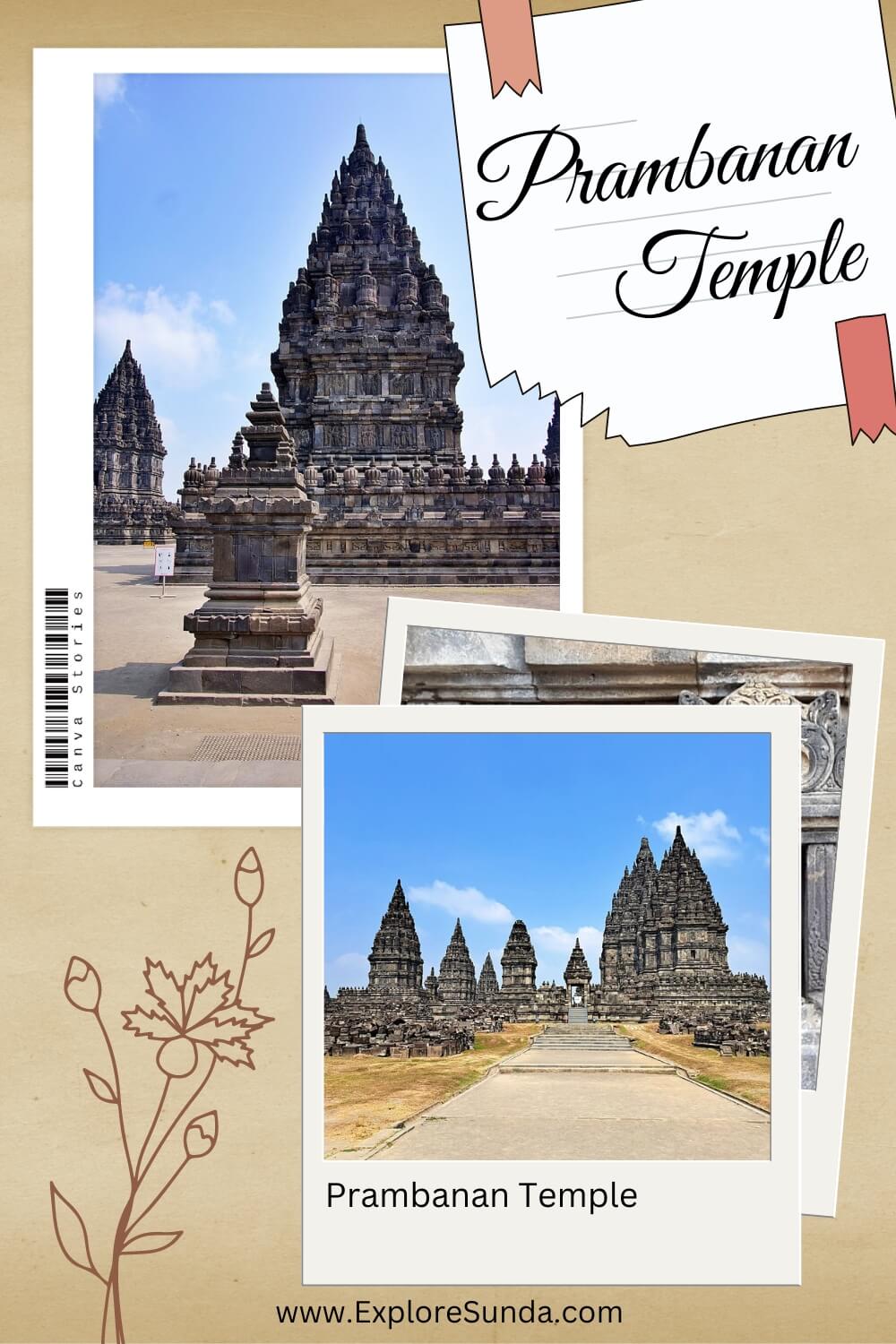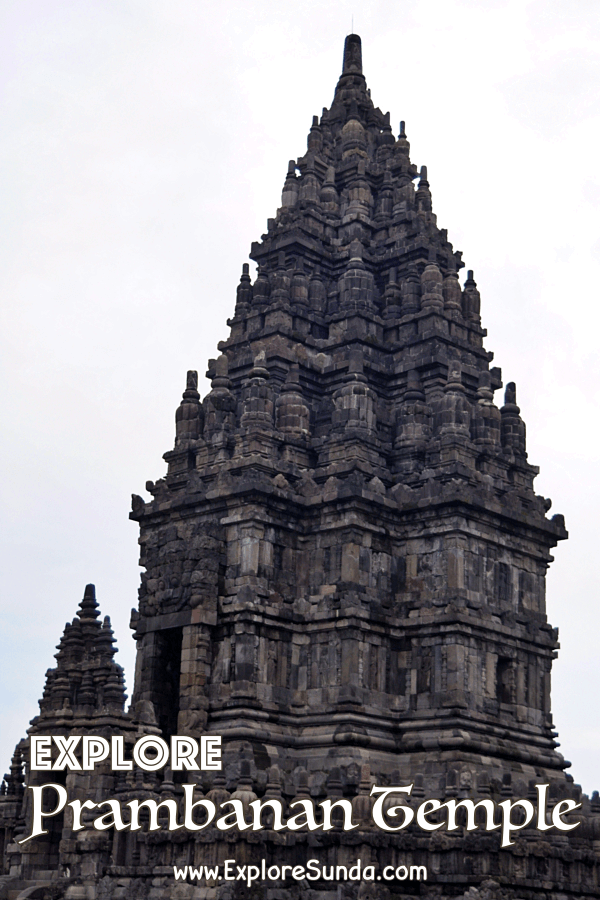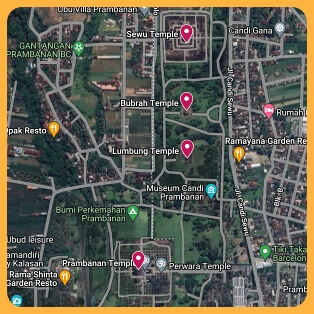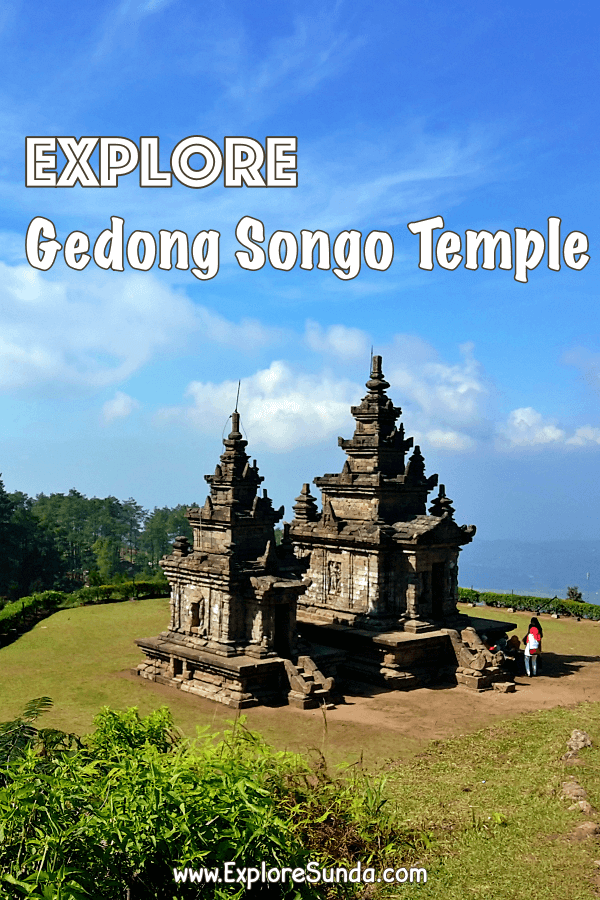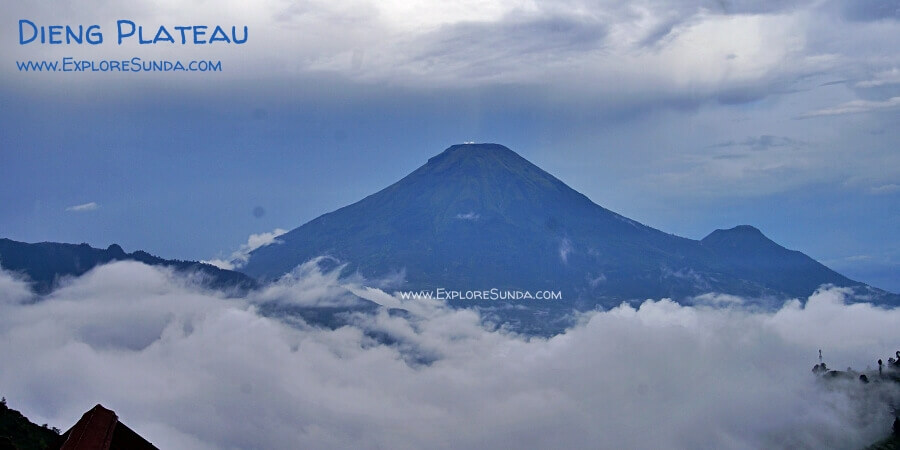- Sunda
- Beyond Sunda
- Prambanan Temple
Prambanan Temple
Prambanan Temple, also known as Candi Prambanan in Bahasa Indonesia, is the most famous Hindu temple in Indonesia that has been on the UNESCO World Heritage Sites list since 1991. It is located in Prambanan village, within an eighty-hectare archaeological park, with three other temples: Candi Sewu, Candi Lumbung, and Candi Bubrah.
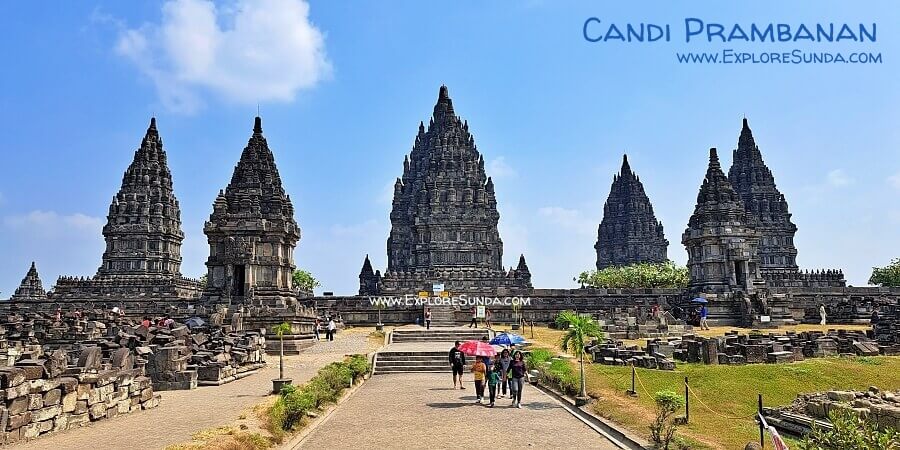 Prambanan Temple, the most famous Hindu temple in Indonesia.
Prambanan Temple, the most famous Hindu temple in Indonesia.The History of Prambanan Temple
Setting aside the legend of Roro Jonggrang (Bandung Bondowoso built Roro Jonggrang temple and the remaining 999 temples in one night), it was Rakai Pikatan from the Sanjaya dynasty who built Prambanan temple in 850 AD. While Rakai Pikatan built the temples in the inner zone, his successors, Dyah Lokapala and then Dyah Balitung, built the remaining temples in the compound.
The Shivagrha inscription found in the complex mentions the inauguration of a temple called Shivagrha (the house of Shiva in English), also known as Shivalaya (the realm of Shiva), by King Lokapala in 856 AD. However, this temple is more commonly known as Candi Prambanan, named after its location in the Prambanan subdistrict. Some believe that Prambanan may be a Javanese dialect for Para Brahman, which means the God Almighty in Hinduism. Others suggest that the name refers to the many Brahmins who lived in the temple compound during its golden age.
Prambanan temple was a Hindu shrine that comprised three zones: outer, middle, and inner zones, representing the earthly (Bhurloka) to Bhuvarloka and ending up at the holiest (Svarloka). Every zone used to have stone walls that separated them, but nowadays, you can only see its foundation. Since the compound depicted Mount Meru (the abode of Gods in Hinduism), the inner area was a square elevated platform, with several stairs from the outer zone to reach the center.
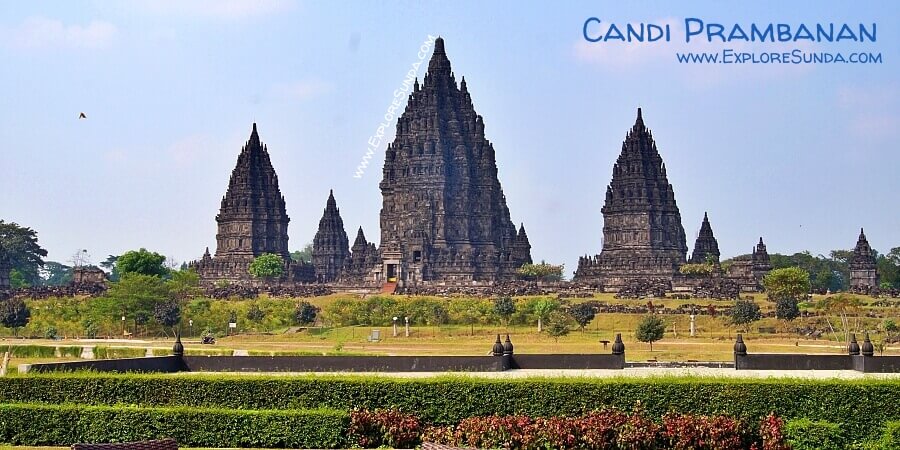 The view of Prambanan Temple from Rama Shinta Garden Restaurant.
The view of Prambanan Temple from Rama Shinta Garden Restaurant.Prambanan Temple was dedicated to the three divine Gods of Hinduism: Siva (the destroyer), Brahma (the creator), and Vishnu (the keeper). The largest temple in Prambanan was devoted to Shiva. It was a thirty-four-meter-wide and forty-seven-meter-high tower with many spires on its roof. There were five chambers inside the temple. Archaeologists believe the three-meter statue of Shiva Mahadeva in the main chamber was the personification of Shiva in the form of King Balitung Mahasambu. You can access this room through the east antechamber. Arcas related to Shiva filled the remaining chambers: Durga in the north, Ganesha in the west, and Agastya in the south room. The main entrance to this temple was on the east side. After you ascend the stairs, you will see another astounding feature of the Prambanan temple: the relief of the Ramayana epic carved on its walls. To read it, you circle the temple clockwise. The story does not end there. It continues to Brahma temple. On the other hand, the Vishnu temple has its own relief of Krishnayana. It narrates the life story of Krishna as a Vishnu reincarnate.
A super short version of Ramayana Epic
Ramayana is a Sanskrit epic from Ancient India (circa eighth century BC - third century AD), which was adopted into Ancient Javanese literature. It was a series of seven books written by Valmiki.
Ramayana is the story of Rama's journey from being a crown prince of the Kosala kingdom to winning a competition to wed Sita (or Shinta in Bahasa Indonesia) and then being exiled for fourteen years. During the exile, Ravana (or Rahwana in Bahasa Indonesia), the giant king from Alengka, abducted Sita. On his way to Alengka, Rama helped Sugriwa, the monkey King from Kishkinda, to win the war against his brother. In return, Sugriwa provided an army and his knight, Hanuman – the white monkey, to assist Rama in freeing Sita. Rama defeated Ravana and brought Sita home, where he ascended the throne of Kosala.
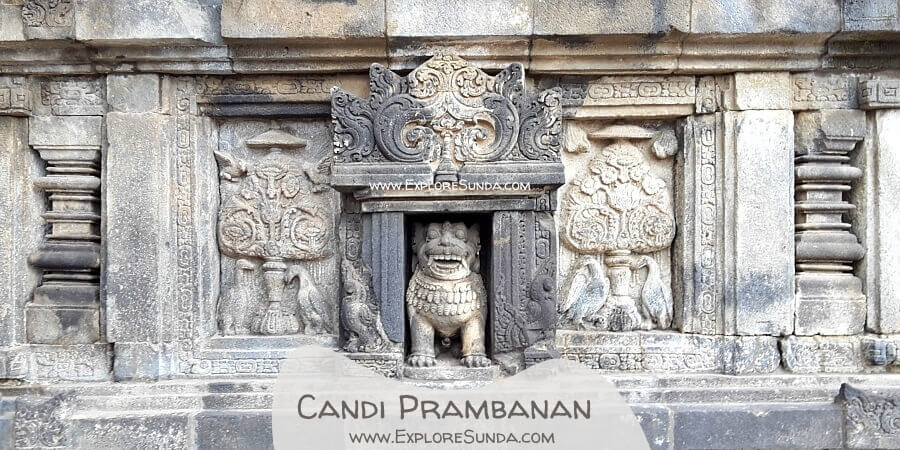 The Prambanan Panel: a lion in an alcove, flanked by two Kalpataru (Kalpavriksha, the wish-fulfilling sacred trees), which are flanked by a pair of animals on each side.
The Prambanan Panel: a lion in an alcove, flanked by two Kalpataru (Kalpavriksha, the wish-fulfilling sacred trees), which are flanked by a pair of animals on each side.You can see the relief of the Ramayana Epic in the temple of Shiva and Brahma in Candi Prambanan. Another visualization of this epic is the Sendratari Ramayana. Sendratari is one of the Javanese dance theatrical performances, often called Wayang Orang in Bahasa Indonesia (Wayang Wong in Javanese). The performers wear traditional Javanese costumes, some wear masks, and tell the story through Javanese dances. This show becomes more special when they perform in the open theater, with the Prambanan temple as the background. The outdoor stage of Ramayana Ballet starts at 7.30 PM every Tuesday, Thursday, and Saturday. from May until October. However, during the rainy season (between November and April), it was held indoors at Trimurti Theater.
The Brahma and Vishnu temples are smaller than the Shiva temple. They flank the Shiva temple, the temple of Brahma on the south side, and the temple of Vishnu on the north side of Shiva temple. Together, they are the Trimurti, the triple deity of the supreme divinity in Hinduism.
According to Hindu mythology, Siva rides a bull named Nandi, Brahma rides a sacred swan named Hamsa, and Vishnu rides a mythical bird called Garuda. These vehicles of Gods have their own shrines in front of the temples of the respective Gods. Presently, only Nandi is in its temple, while the temples of Hamsa and Garuda are empty.
Besides these three main temples and three Vahana temples, ten small shrines circled them:
- Two Apit (flank) temples, located between the main temples and Vahana temples,
- Four Kelir (screen in English) temples on four cardinal directions, erected right in front of the four entrances to the inner zone,
- Four Patok (peg in English) temples on every corner of the inner zone.
These sixteen temples made up the inner zone.
Going down some steps will take you to the middle section, where four layers of Pervara (guardian) temples circle the inner zone. The first layer has 44 temples, the second has 52, the third has 60, and the fourth has 68. These temples are identical – small and plain shrines with stairs leading to the archway – except for the ones in the corners, which have two archways and two sets of stairs. So, in total, Prambanan temple comprises 240 temples (16 temples in the inner zone surrounded by 224 Pervara temples).
During its golden age, the Prambanan temple was the royal shrine and the center of Hinduism in Java. Historians believe that once upon a time, many Brahmins lived in the outer zone of Candi Prambanan. However, less than a century after its inauguration, Mpu Sindok moved the kingdom from Central Java to East Java. It seemed that it was due to the massive eruption of Mount Merapi in the tenth century. As a result, Candi Prambanan was shattered, abandoned, and forgotten.
Centuries later, inhabitants near the temple compounds were no longer Hindu or Buddhist followers. They did not know the history behind the piles of rocks near their village. Hence, a folktale emerged, a story about fallen kingdoms, a prince with supernatural power, and a cursed princess. This story became a famous legend of Roro Jonggrang.
In the legend of Roro Jonggrang, Bandung Bondowoso cursed Roro Jonggrang to become the statue in the 1000th temple, presumably the statue of Durga in the north chamber of Shiva temple in Candi Prambanan. Nowadays, this legend comes to life at the Trimurti Indoor Theater – the same theater they use for Sendratari Ramayana. For one hour, you will be enthralled with the classic Javanese performance of the Sendratari Roro Jonggrang. If you are interested, the show takes place every Friday, from 19.30 to 20.30.
Candi Prambanan Present Day
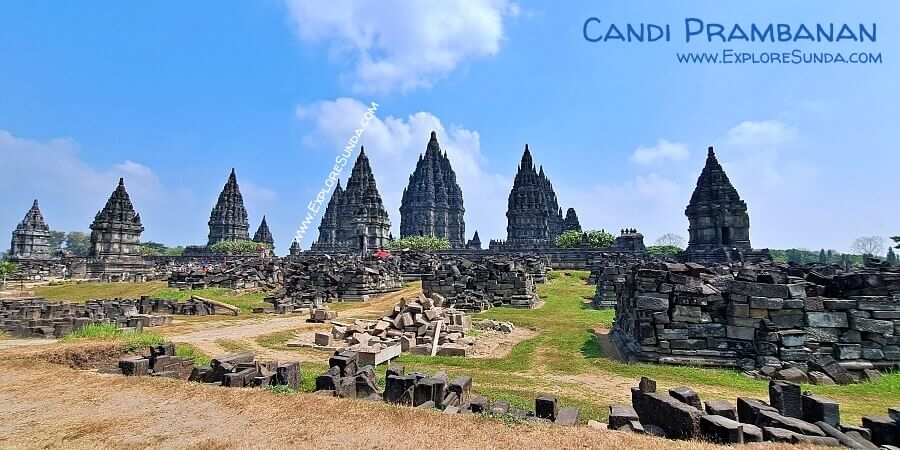 Candi Prambanan with three of its completely renovated Pervara temples.
Candi Prambanan with three of its completely renovated Pervara temples.Today, Prambanan temple lies in the eighty-hectare archaeological park. It is a massive park and is often scorchingly hot from mid-morning until afternoon, especially during the dry season. Hence, a hat or an umbrella, comfortable clothes, and walking shoes are recommended. Plus, you might want to start early to avoid the heat (the park opens at seven in the morning).
Although the restoration of the Prambanan temple has been started since the early twentieth century, it is a never-ending project, when earthquakes and volcano eruptions often disrupt and destroy progress. It took nine years to repair the damage from the 2006 earthquake.
Fast forward to 2023, all temples in the inner zone have been fully restored, although some chambers are still empty. As you stroll through these temples, you will be awed by their magnificent appearance. Can you imagine, without any modern technology, those people built 240 temples in a precise geometrical pattern. Please note the inner zone is closed for cleaning and preservation every Monday. Since the iron fence is low, you can still take some pictures of the temples from that point. However, you will not be able to see the Ramayana relief or get a glimpse of the inner sanctums. Hence, to experience the full beauty of the Prambanan temple, plan your visit between Tuesdays and Sundays.
On the other hand, up to now, only six of the 224 Pervara temples have been renovated (the last one was completed in 2022), while the remaining temples are piles of stones and parts of the foundation of the temples. It is almost impossible to restore them all since the stone blocks are scattered everywhere due to the earthquake, looting, and thievery.
Alternatives to admire the beauty of Prambanan Temple
Of course, the best way to explore the Prambanan temple is on foot. You can walk around the temples and admire the details. However, not all visitors can walk that long. You might prefer to enjoy the beauty of the Prambanan temple by renting a golf car. In 2023, the rental price was Rp. 200,000 (cash only). One golf car can take up to six people. In thirty minutes, it will circle Prambanan Park, with short stops at Candi Prambanan and Candi Sewu, where you can take pictures. It will not stop at Candi Lumbung and Candi Bubrah. However, these golf cars are only allowed on the outer road. Hence, it will take you to the back side of Prambanan temple. On the other hand, riding a golf car is very convenient for going to the remaining temples in the park, especially Sewu temple, which is the furthest from the entrance and exit gates.
Do you know that you can enjoy the view of the Prambanan temple while taking a break? Rama and Shinta Restaurant on the other side of the Opak River has an unobstructed view of the temple compound. Where else can you have tasty food with an extraordinary landscape? If you walk to this restaurant, look for a pedestrian path from Prambanan Park, which will lead you to a bridge, and voila, you turn up at the restaurant. However, if you drive a car, you must exit the park and find the way to the west. We did it by following the outer side of the park. Parking there is convenient because the restaurant has a sizable parking lot.
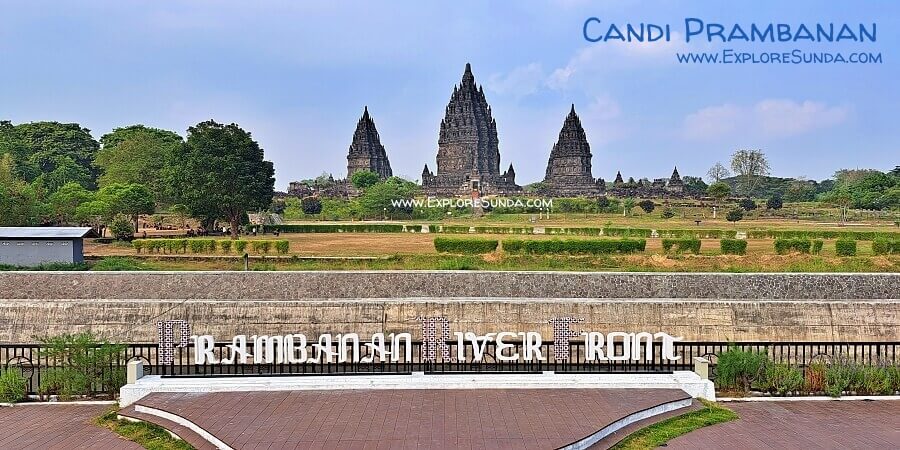 The view of Prambanan Temple from the Rama Shinta Garden Restaurant.
The view of Prambanan Temple from the Rama Shinta Garden Restaurant.Can you imagine the beauty of the Prambanan temple at night? It is mesmerizing, especially during the Ramayana Ballet at the open (outdoor) stage. In Bahasa Indonesia, it is called Sendratari Ramayana, where the performers wear traditional Javanese costumes, some wear masks, and tell the story of the Ramayana epic through Javanese music and dances.
From May until October, the show is held on the open (outdoor) stage. It starts at 7.30 PM every Tuesday, Thursday, and Saturday. They still perform during the rainy season (between November and April) at Trimurti Indoor Theater. The outdoor stage, the Trimurti Theater, and the Rama Shinta Garden Resto are all in the same area: across the Opak River, with an unobstructed view of the Prambanan temple.
Directions to Prambanan Temple
Ticket:
Indonesian: Rp.50,000
non-Indonesian: USD.25
Opening Hours:
6.30-17.00 Daily
Located at Jalan Raya Solo - Yogyakarta no. 16, Candi Prambanan is accessible from Solo and Yogyakarta. Since it is approximately seventeen kilometers from downtown Jogja, the most convenient way to get there is by hailing ride-sharing services (Gojek and Grab) or taxis. If you prefer public transportation, you can catch Transjogja bus route 1A, which will take you from Mangkubumi bus stop near Tugu train station through Malioboro Street to Prambanan bus stop, which is about one kilometer from the ticket office. Or you can catch any intercity bus to Solo from Giwangan bus station in Yogyakarta. The GPS coordinates are 7°45'18.3"S 110°29'36.0"E.
Recent Articles
-
Discover the Vibrant Celebration of Imlek in Indonesia!
Jan 13, 25 03:24 AM
The Chinese New Year of 2576 will be celebrated on January 29, 2025. Discover the special things in this Imlek festival! -
The Site Map of ExploreSunda.com
Nov 26, 24 10:40 PM
A thorough site map to help you browse through the Explore Sunda site. -
The Best Road Trip to Dieng Plateau Wonosobo: Sightseeing, Eat & Sleep
Nov 19, 24 11:52 PM
Explore the stunning Dieng Plateau in Wonosobo, with its cold above the cloud highlands, ancient temples, and breathtaking tea plantations. Visit in August and treat yourself to the Dieng Culture Fest…
